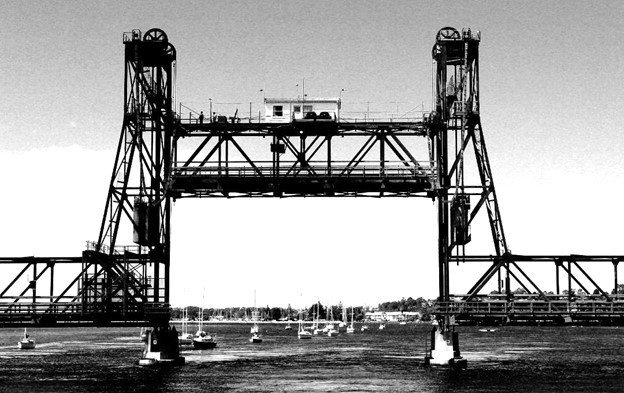South Coast NSW History Story
The (old) Batemans Bay Bridge
It was heritage listed, and parts of it (such as its towers) were considered to have ‘exceptional’ heritage significance, and it was an iconic ‘gateway’ to the town… but the original Batemans Bay Bridge was demolished. As happened with its predecessor (a motorized car ferry), the bridge was no longer capable of adequately handling the traffic flow – so it just had to go!
The main coastal road between Sydney and Victoria (now called the Princes Highway) once included several crossings of waterways by ferry. As funds became available, bridges were constructed to replace all of these ferries.
The ferry crossing of the Clyde River at Batemans Bay was installed in 1871 and, subsequently, was upgraded on several occasions. By the time the Batemans Bay Bridge was opened in November 1956, the Clyde River ferry had become the last remaining vehicular ferry on the Princes Highway in NSW and was carrying over 233,000 vehicles per year. Delays experienced in crossing the river not-infrequently exceeded one hour…and, for those travelling to or from Canberra, that was on top of significant delays also experienced crossing the Clyde River by ferry at Nelligen.
Preliminary work to construct the Batemans Bay Bridge started before World War II but was put on hold when essential war-related industries resulted in shortages of materials and skilled labour. Tenders for construction of the bridge were finally sought in October 1947.
But continuing post-war shortages of materials and skilled labour meant that construction of the bridge then proceeded at a snail’s pace.
In the early 1950s almost all or the piers had been driven down to rock foundations – in some cases to more than 60 feet below the river’s high-water mark. Headstocks (the reinforced pads that sit on the piers and which carry the structural steel of the bridge) were gradually added. But it was not until the mid-1950s, by which time the post-war shortage of materials had eased, that construction of the bridge began in earnest.
The bridge was finally opened to traffic on November 21st, 1956. It had cost £350,000 to build.
The impact on Batemans Bay township (and on townships further south) was profound. One wonders whether the thousands of people who attended the official opening of the bridge actually realized how much difference the bridge would make to their community: the pace of life in town rapidly changed and, as one resident observed ‘new people came to town, we had more visitors, we started locking our doors and locking our cars – we had never done that before!’
The Batemans Bay Bridge was what is termed a ‘Vertical Lift Bridge’. It had (very obvious) counterweights that moved down when the central section was raised (a quite different arrangement to the other common form of moveable bridge, the Bascule Bridge (the modern equivalent of the old castle drawbridge) - of which the Narooma Bridge is an example – which often has a counterweight rigidly attached to the end of the structure that is raised, but which is not as immediately obvious a feature of the bridge). The Batemans Bay Bridge could be lifted to provide a clearance of 75 feet above the river’s high-water mark.
The Batemans Bay Bridge was basically the same design as was the Hexham Bridge (spanning the Hunter River upstream of Newcastle, although Hexham’s lift is higher than that of the Batemans Bay Bridge), the Ryde Bridge at Meadowbank in Sydney, the Wardell Bridge over the Richmond River, and the Clarence River Bridge at Harwood.
Records indicate that the Batemans Bay Bridge was raised, for example, 664 times during 2011 (almost twice a day) to enable shipping to proceed up or down river, under its lifting span.
In May 2012 the Bay Post recorded the retirement of the bridge operator George Merceica, who had held the position for 20 years. One memorable ‘near miss’ that he related occurred when the automated vehicle gates wouldn’t close and Mr Merceica had to stop the passing traffic by placing traffic cones across the bridge before climbing the ladder to the engine house atop of the bridge. One motorist, however, was reluctant to wait and, just as Mr. Merceica commenced lifting the bridge, the driver accelerated and attempted to cross the bridge before it had been opened. Fortunately, he was able to brake hard, just in time to avoid plummeting into the river!!
The construction of the Batemans Bay Bridge, together with the concurrent construction of the Tuross River Bridge near Bodalla (replacing a temporary bridge that had been installed when an earlier bridge collapsed during floods in April 1945), coincided with the demise of coastal shipping along the South Coast.
Its opening, therefore, had a significant impact on transportation to the area. Road transport along the coast became quicker and easier - and this instantly became the dominant form of transportation to the area – and an increase in town and village development resulted along the full length of the South Coast.
Sources: RMS ‘Moveable Span Bridge Study’; State Heritage Inventory listing; ‘History of the Bridge over the Clyde River on Princes Hwy at Batemans’s Bay’ in Main Roads Journal, March 1948 and December 1956; ‘Princes Highway History and Development’ at ozroads.com.au; information supplied by Clyde River and Batemans Bay Historical Society.
Photograph by Ted Richards
